Comprehensive Analysis of Organisational Performance at Tesco Plc
VerifiedAdded on 2023/03/23
|19
|3494
|72
Report
AI Summary
This report provides a detailed analysis of Tesco Plc's organizational performance, examining various performance measurement systems and techniques. It begins with an overview of Tesco's operations, business environment, and activities, followed by an explanation of the methodologies used, including secondary research and case study analysis. The report then delves into the Alternative Performance Measures (APMs) employed by Tesco, such as group sales, like-for-like sales, operating profit, cash flow, and net debt. It evaluates these measures in the context of theoretical performance management models, including productivity, effectiveness, and organizational ranking. The report also discusses models like the DSMC/ATI Model and the Multi-Source Feedback Model for performance improvement, offering a comprehensive understanding of organizational performance evaluation and providing recommendations for enhancing Tesco's practices. The analysis is supported by literature reviews and real-world examples.
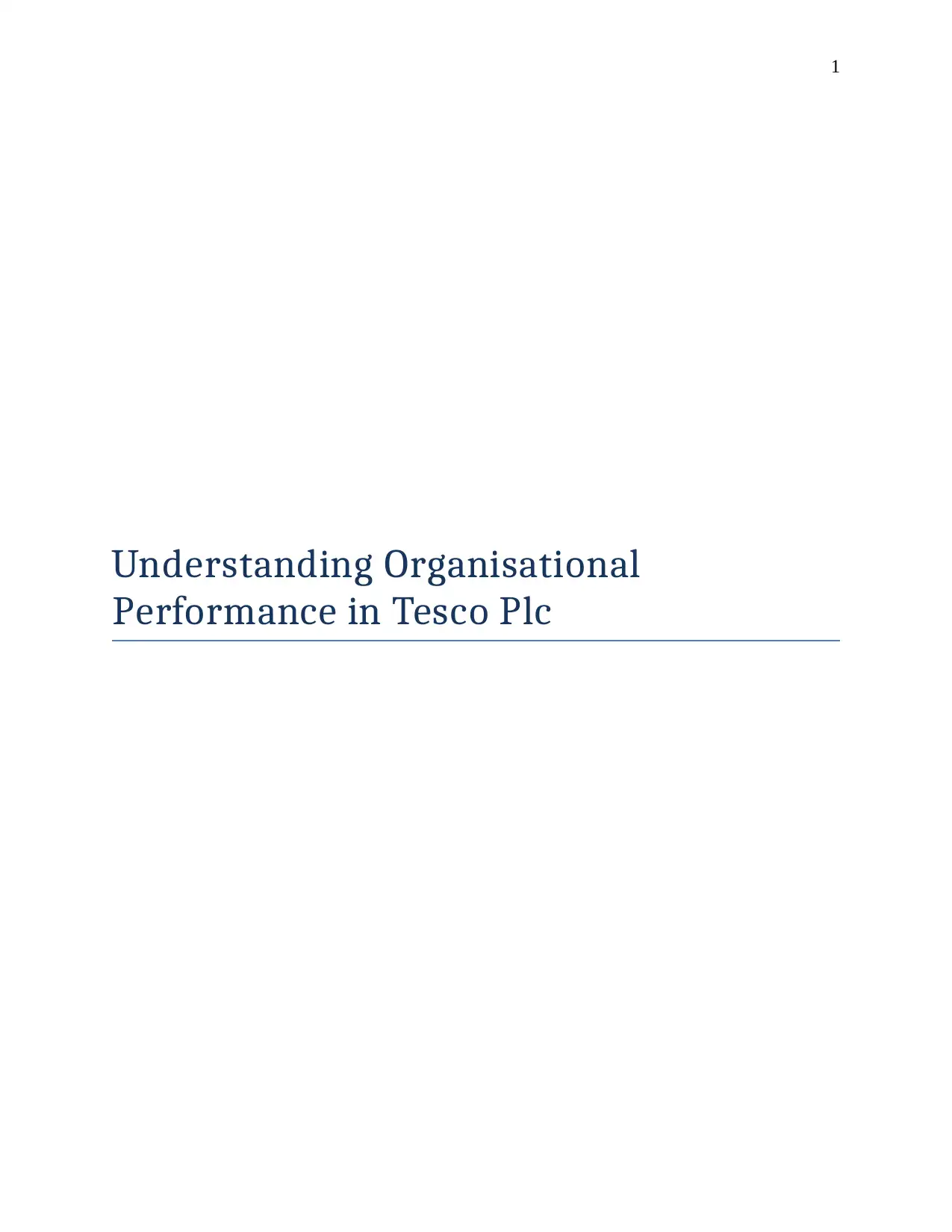
1
Understanding Organisational
Performance in Tesco Plc
Understanding Organisational
Performance in Tesco Plc
Paraphrase This Document
Need a fresh take? Get an instant paraphrase of this document with our AI Paraphraser
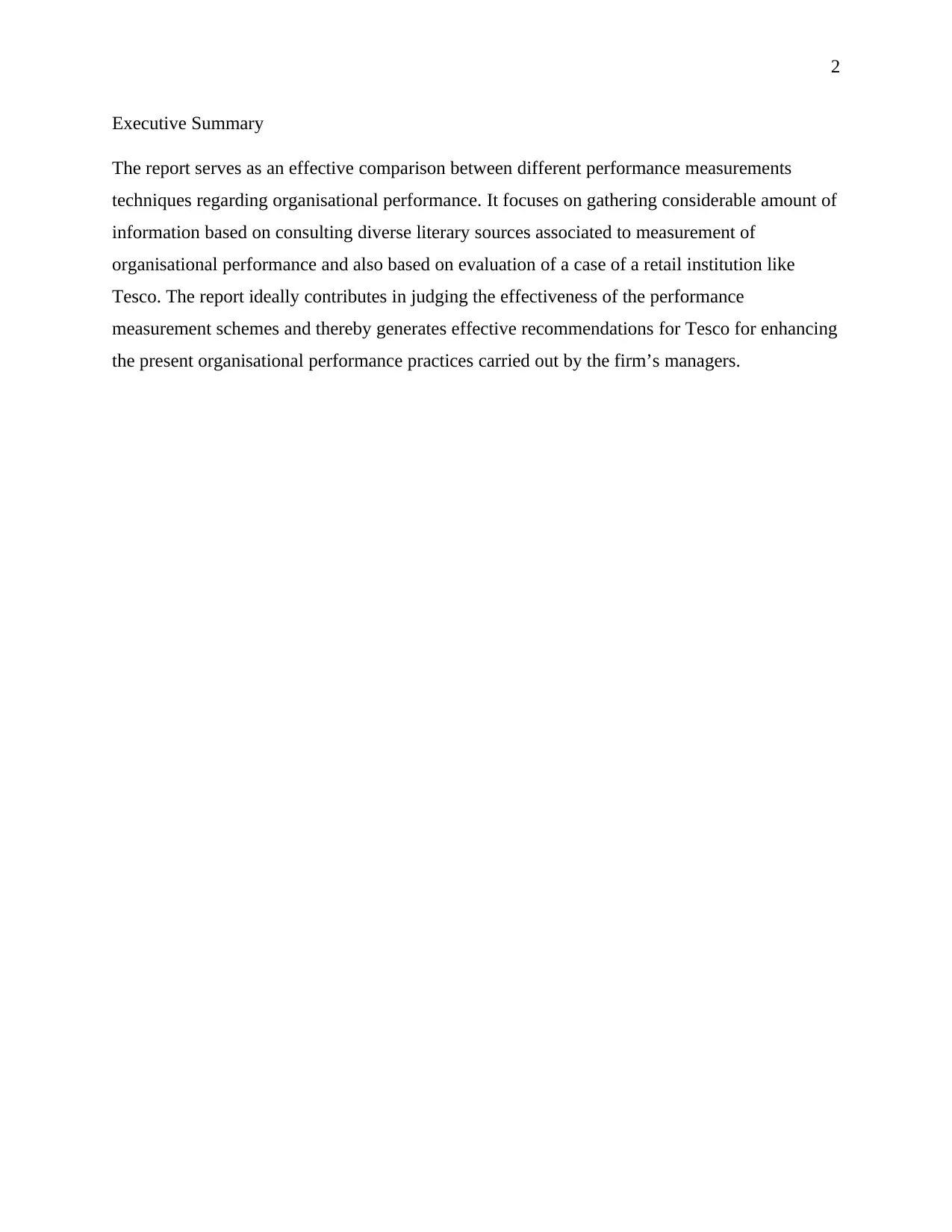
2
Executive Summary
The report serves as an effective comparison between different performance measurements
techniques regarding organisational performance. It focuses on gathering considerable amount of
information based on consulting diverse literary sources associated to measurement of
organisational performance and also based on evaluation of a case of a retail institution like
Tesco. The report ideally contributes in judging the effectiveness of the performance
measurement schemes and thereby generates effective recommendations for Tesco for enhancing
the present organisational performance practices carried out by the firm’s managers.
Executive Summary
The report serves as an effective comparison between different performance measurements
techniques regarding organisational performance. It focuses on gathering considerable amount of
information based on consulting diverse literary sources associated to measurement of
organisational performance and also based on evaluation of a case of a retail institution like
Tesco. The report ideally contributes in judging the effectiveness of the performance
measurement schemes and thereby generates effective recommendations for Tesco for enhancing
the present organisational performance practices carried out by the firm’s managers.
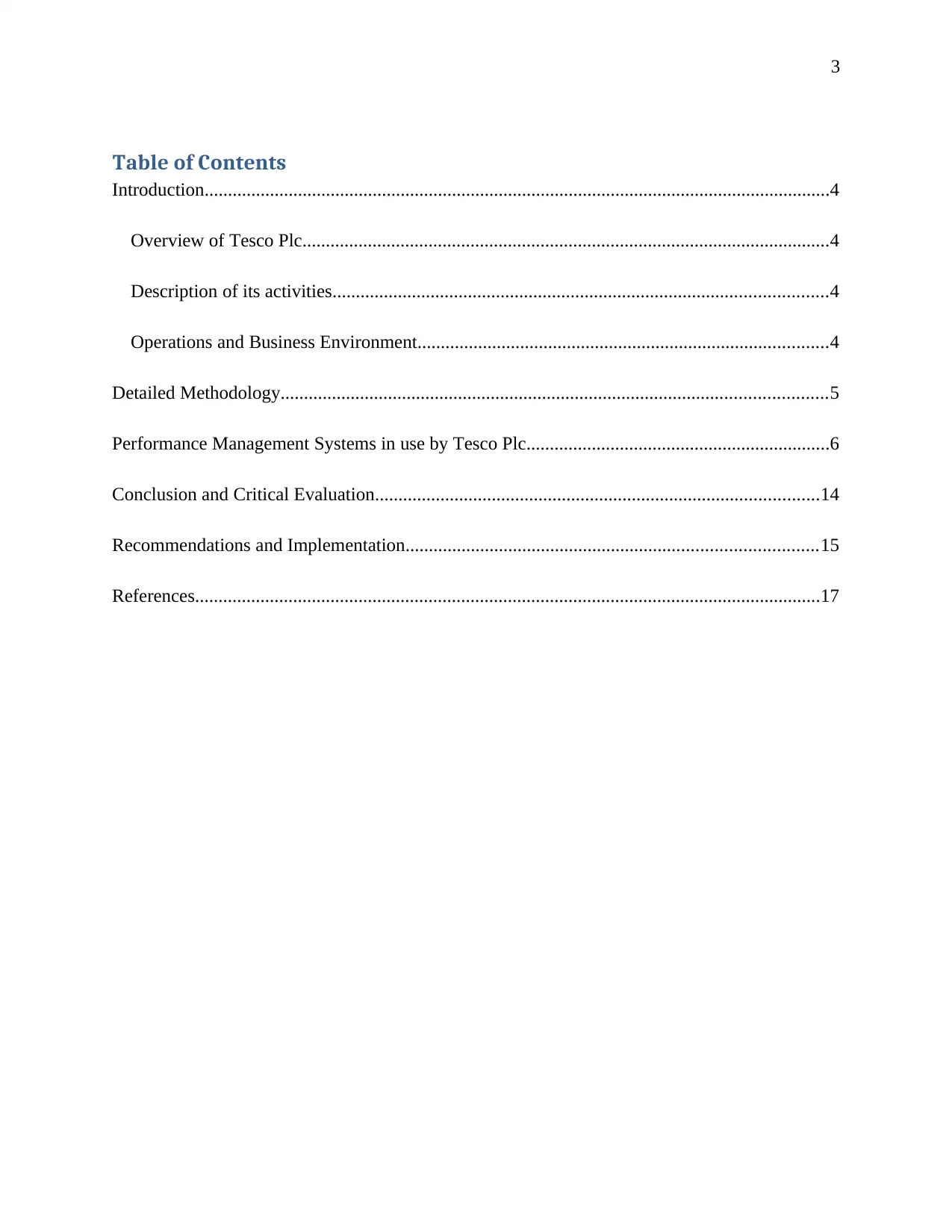
3
Table of Contents
Introduction......................................................................................................................................4
Overview of Tesco Plc.................................................................................................................4
Description of its activities..........................................................................................................4
Operations and Business Environment........................................................................................4
Detailed Methodology.....................................................................................................................5
Performance Management Systems in use by Tesco Plc.................................................................6
Conclusion and Critical Evaluation...............................................................................................14
Recommendations and Implementation........................................................................................15
References......................................................................................................................................17
Table of Contents
Introduction......................................................................................................................................4
Overview of Tesco Plc.................................................................................................................4
Description of its activities..........................................................................................................4
Operations and Business Environment........................................................................................4
Detailed Methodology.....................................................................................................................5
Performance Management Systems in use by Tesco Plc.................................................................6
Conclusion and Critical Evaluation...............................................................................................14
Recommendations and Implementation........................................................................................15
References......................................................................................................................................17
⊘ This is a preview!⊘
Do you want full access?
Subscribe today to unlock all pages.

Trusted by 1+ million students worldwide
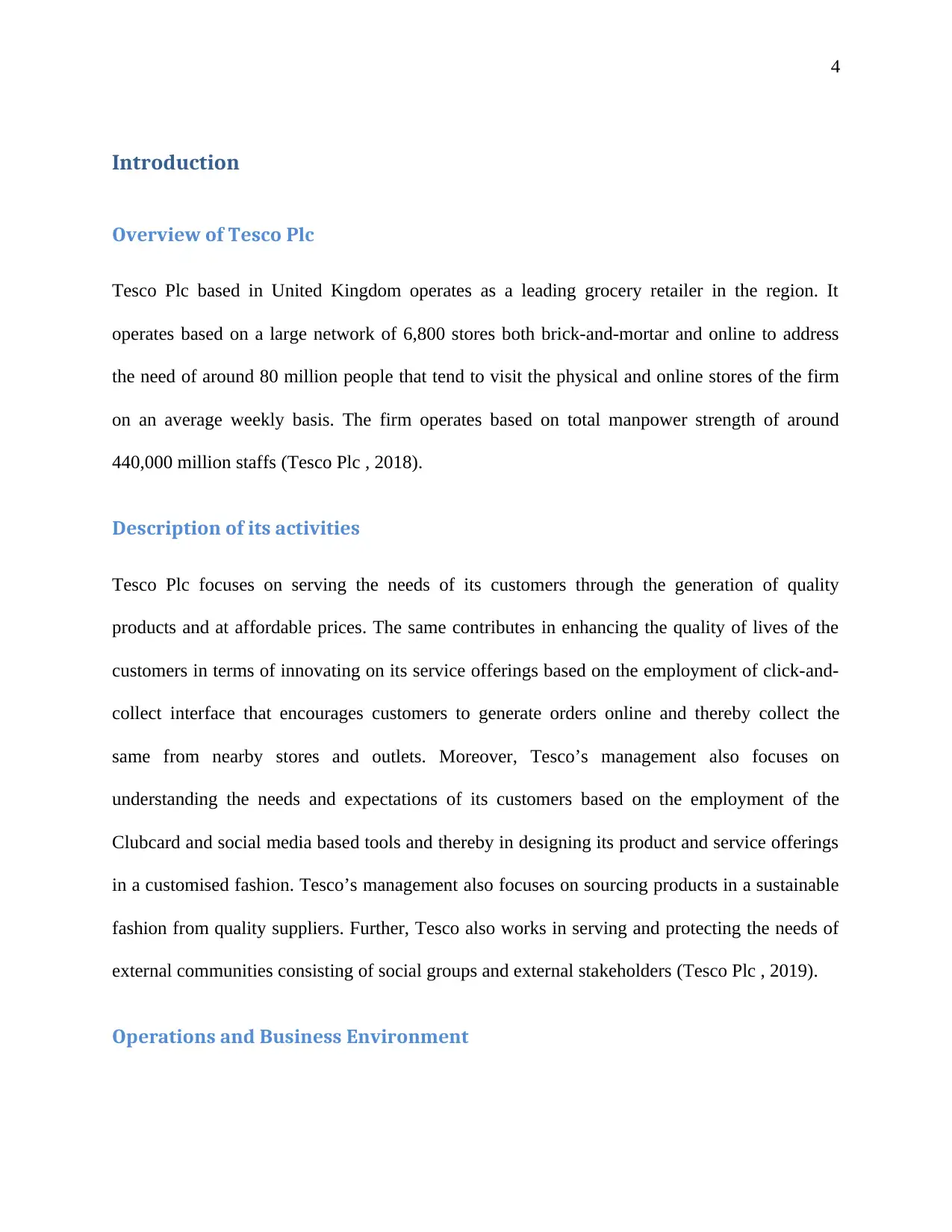
4
Introduction
Overview of Tesco Plc
Tesco Plc based in United Kingdom operates as a leading grocery retailer in the region. It
operates based on a large network of 6,800 stores both brick-and-mortar and online to address
the need of around 80 million people that tend to visit the physical and online stores of the firm
on an average weekly basis. The firm operates based on total manpower strength of around
440,000 million staffs (Tesco Plc , 2018).
Description of its activities
Tesco Plc focuses on serving the needs of its customers through the generation of quality
products and at affordable prices. The same contributes in enhancing the quality of lives of the
customers in terms of innovating on its service offerings based on the employment of click-and-
collect interface that encourages customers to generate orders online and thereby collect the
same from nearby stores and outlets. Moreover, Tesco’s management also focuses on
understanding the needs and expectations of its customers based on the employment of the
Clubcard and social media based tools and thereby in designing its product and service offerings
in a customised fashion. Tesco’s management also focuses on sourcing products in a sustainable
fashion from quality suppliers. Further, Tesco also works in serving and protecting the needs of
external communities consisting of social groups and external stakeholders (Tesco Plc , 2019).
Operations and Business Environment
Introduction
Overview of Tesco Plc
Tesco Plc based in United Kingdom operates as a leading grocery retailer in the region. It
operates based on a large network of 6,800 stores both brick-and-mortar and online to address
the need of around 80 million people that tend to visit the physical and online stores of the firm
on an average weekly basis. The firm operates based on total manpower strength of around
440,000 million staffs (Tesco Plc , 2018).
Description of its activities
Tesco Plc focuses on serving the needs of its customers through the generation of quality
products and at affordable prices. The same contributes in enhancing the quality of lives of the
customers in terms of innovating on its service offerings based on the employment of click-and-
collect interface that encourages customers to generate orders online and thereby collect the
same from nearby stores and outlets. Moreover, Tesco’s management also focuses on
understanding the needs and expectations of its customers based on the employment of the
Clubcard and social media based tools and thereby in designing its product and service offerings
in a customised fashion. Tesco’s management also focuses on sourcing products in a sustainable
fashion from quality suppliers. Further, Tesco also works in serving and protecting the needs of
external communities consisting of social groups and external stakeholders (Tesco Plc , 2019).
Operations and Business Environment
Paraphrase This Document
Need a fresh take? Get an instant paraphrase of this document with our AI Paraphraser
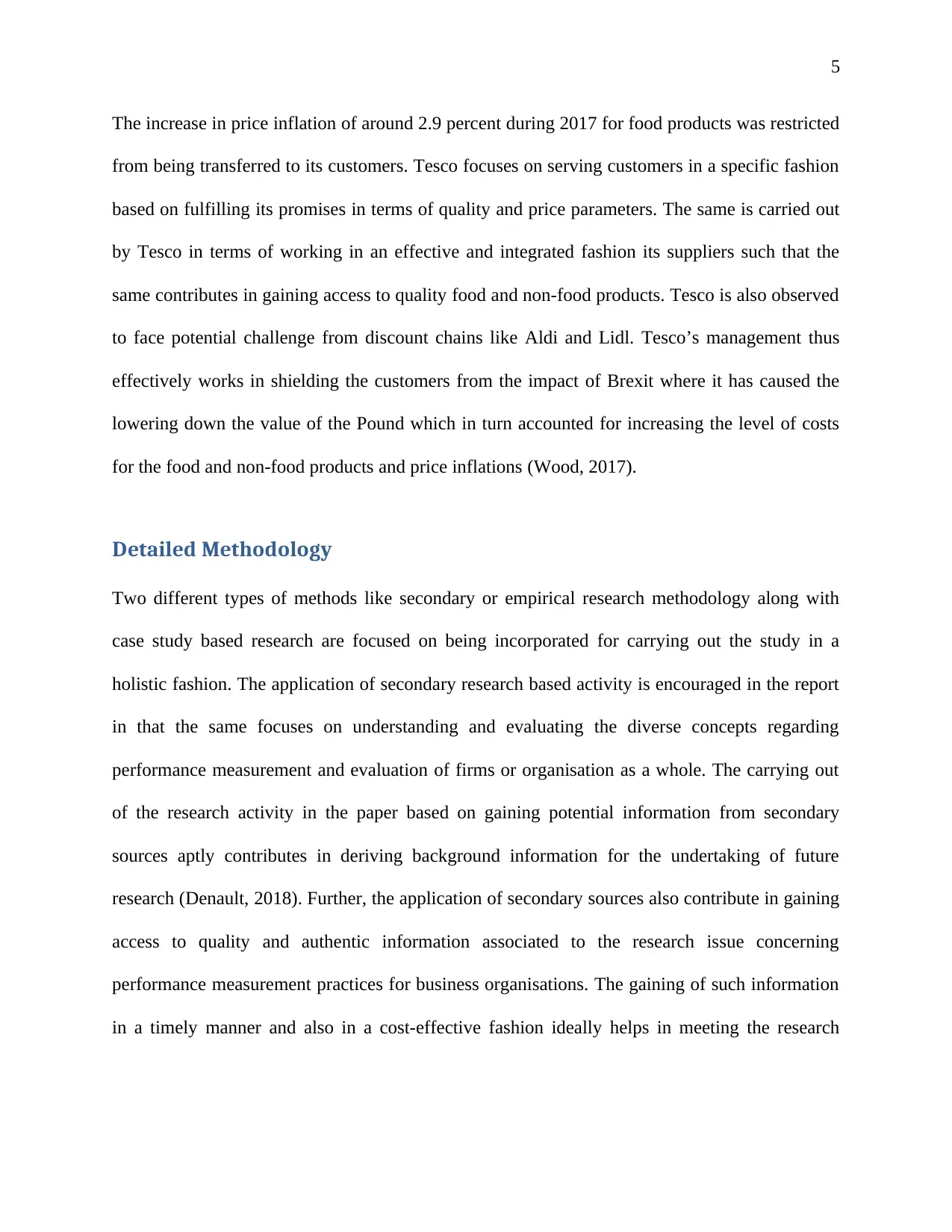
5
The increase in price inflation of around 2.9 percent during 2017 for food products was restricted
from being transferred to its customers. Tesco focuses on serving customers in a specific fashion
based on fulfilling its promises in terms of quality and price parameters. The same is carried out
by Tesco in terms of working in an effective and integrated fashion its suppliers such that the
same contributes in gaining access to quality food and non-food products. Tesco is also observed
to face potential challenge from discount chains like Aldi and Lidl. Tesco’s management thus
effectively works in shielding the customers from the impact of Brexit where it has caused the
lowering down the value of the Pound which in turn accounted for increasing the level of costs
for the food and non-food products and price inflations (Wood, 2017).
Detailed Methodology
Two different types of methods like secondary or empirical research methodology along with
case study based research are focused on being incorporated for carrying out the study in a
holistic fashion. The application of secondary research based activity is encouraged in the report
in that the same focuses on understanding and evaluating the diverse concepts regarding
performance measurement and evaluation of firms or organisation as a whole. The carrying out
of the research activity in the paper based on gaining potential information from secondary
sources aptly contributes in deriving background information for the undertaking of future
research (Denault, 2018). Further, the application of secondary sources also contribute in gaining
access to quality and authentic information associated to the research issue concerning
performance measurement practices for business organisations. The gaining of such information
in a timely manner and also in a cost-effective fashion ideally helps in meeting the research
The increase in price inflation of around 2.9 percent during 2017 for food products was restricted
from being transferred to its customers. Tesco focuses on serving customers in a specific fashion
based on fulfilling its promises in terms of quality and price parameters. The same is carried out
by Tesco in terms of working in an effective and integrated fashion its suppliers such that the
same contributes in gaining access to quality food and non-food products. Tesco is also observed
to face potential challenge from discount chains like Aldi and Lidl. Tesco’s management thus
effectively works in shielding the customers from the impact of Brexit where it has caused the
lowering down the value of the Pound which in turn accounted for increasing the level of costs
for the food and non-food products and price inflations (Wood, 2017).
Detailed Methodology
Two different types of methods like secondary or empirical research methodology along with
case study based research are focused on being incorporated for carrying out the study in a
holistic fashion. The application of secondary research based activity is encouraged in the report
in that the same focuses on understanding and evaluating the diverse concepts regarding
performance measurement and evaluation of firms or organisation as a whole. The carrying out
of the research activity in the paper based on gaining potential information from secondary
sources aptly contributes in deriving background information for the undertaking of future
research (Denault, 2018). Further, the application of secondary sources also contribute in gaining
access to quality and authentic information associated to the research issue concerning
performance measurement practices for business organisations. The gaining of such information
in a timely manner and also in a cost-effective fashion ideally helps in meeting the research
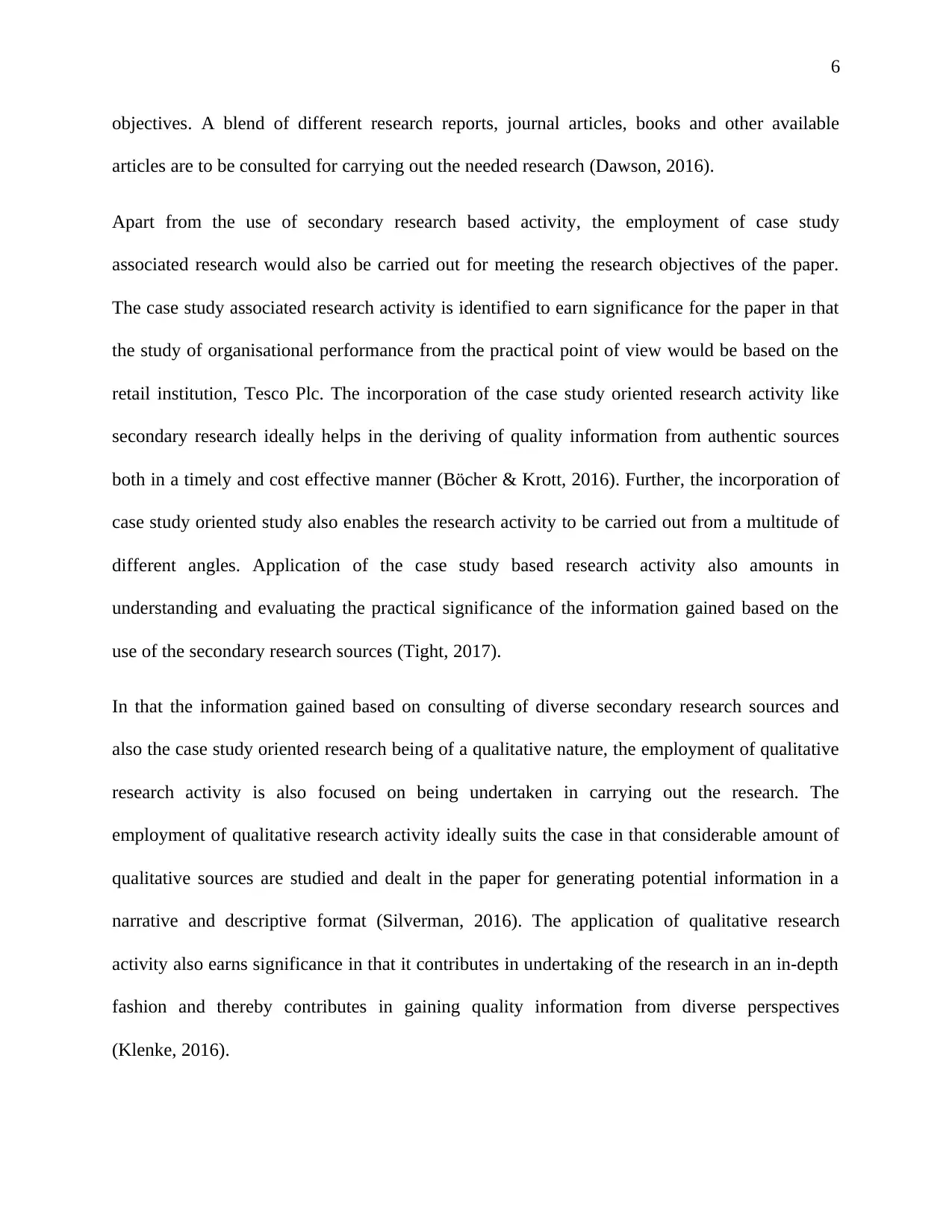
6
objectives. A blend of different research reports, journal articles, books and other available
articles are to be consulted for carrying out the needed research (Dawson, 2016).
Apart from the use of secondary research based activity, the employment of case study
associated research would also be carried out for meeting the research objectives of the paper.
The case study associated research activity is identified to earn significance for the paper in that
the study of organisational performance from the practical point of view would be based on the
retail institution, Tesco Plc. The incorporation of the case study oriented research activity like
secondary research ideally helps in the deriving of quality information from authentic sources
both in a timely and cost effective manner (Böcher & Krott, 2016). Further, the incorporation of
case study oriented study also enables the research activity to be carried out from a multitude of
different angles. Application of the case study based research activity also amounts in
understanding and evaluating the practical significance of the information gained based on the
use of the secondary research sources (Tight, 2017).
In that the information gained based on consulting of diverse secondary research sources and
also the case study oriented research being of a qualitative nature, the employment of qualitative
research activity is also focused on being undertaken in carrying out the research. The
employment of qualitative research activity ideally suits the case in that considerable amount of
qualitative sources are studied and dealt in the paper for generating potential information in a
narrative and descriptive format (Silverman, 2016). The application of qualitative research
activity also earns significance in that it contributes in undertaking of the research in an in-depth
fashion and thereby contributes in gaining quality information from diverse perspectives
(Klenke, 2016).
objectives. A blend of different research reports, journal articles, books and other available
articles are to be consulted for carrying out the needed research (Dawson, 2016).
Apart from the use of secondary research based activity, the employment of case study
associated research would also be carried out for meeting the research objectives of the paper.
The case study associated research activity is identified to earn significance for the paper in that
the study of organisational performance from the practical point of view would be based on the
retail institution, Tesco Plc. The incorporation of the case study oriented research activity like
secondary research ideally helps in the deriving of quality information from authentic sources
both in a timely and cost effective manner (Böcher & Krott, 2016). Further, the incorporation of
case study oriented study also enables the research activity to be carried out from a multitude of
different angles. Application of the case study based research activity also amounts in
understanding and evaluating the practical significance of the information gained based on the
use of the secondary research sources (Tight, 2017).
In that the information gained based on consulting of diverse secondary research sources and
also the case study oriented research being of a qualitative nature, the employment of qualitative
research activity is also focused on being undertaken in carrying out the research. The
employment of qualitative research activity ideally suits the case in that considerable amount of
qualitative sources are studied and dealt in the paper for generating potential information in a
narrative and descriptive format (Silverman, 2016). The application of qualitative research
activity also earns significance in that it contributes in undertaking of the research in an in-depth
fashion and thereby contributes in gaining quality information from diverse perspectives
(Klenke, 2016).
⊘ This is a preview!⊘
Do you want full access?
Subscribe today to unlock all pages.

Trusted by 1+ million students worldwide
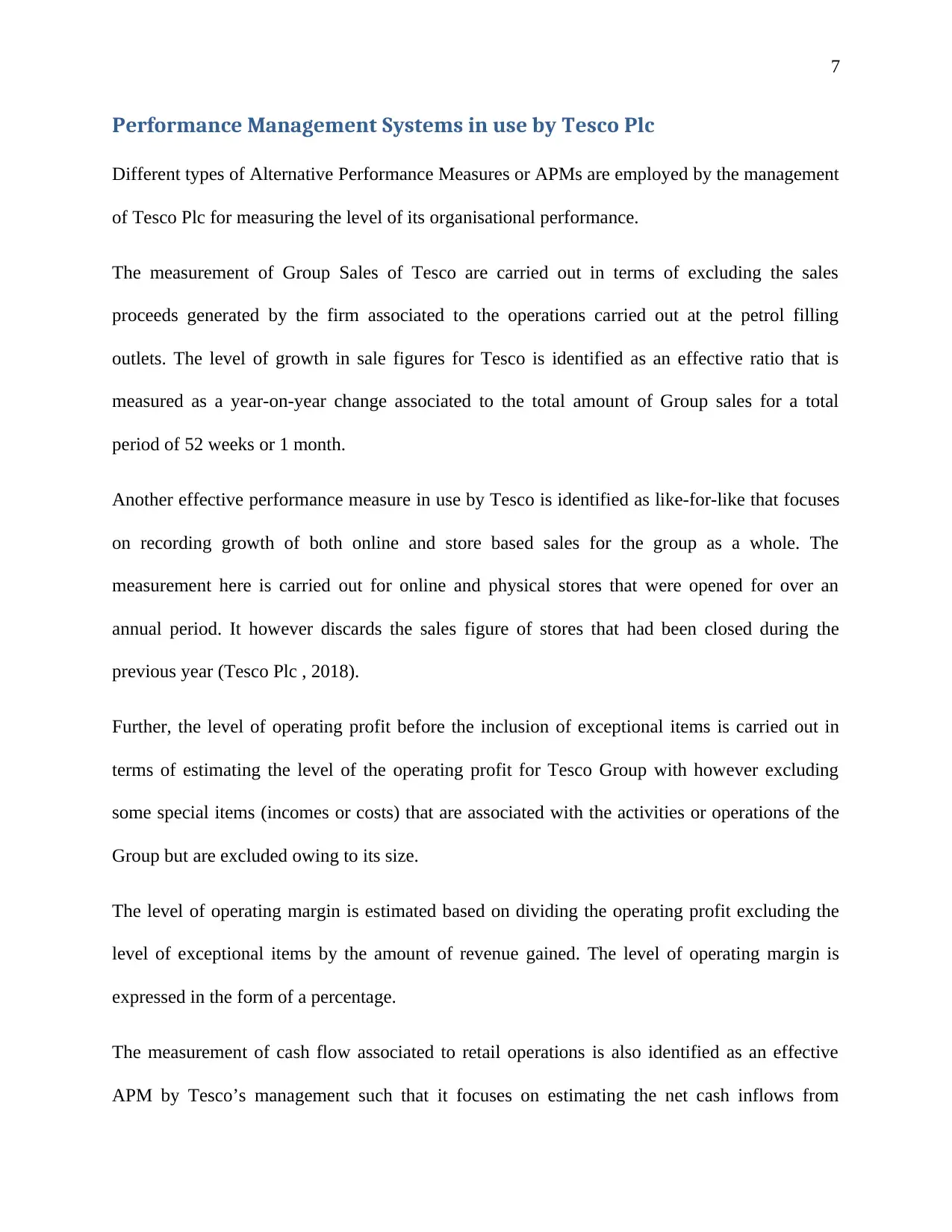
7
Performance Management Systems in use by Tesco Plc
Different types of Alternative Performance Measures or APMs are employed by the management
of Tesco Plc for measuring the level of its organisational performance.
The measurement of Group Sales of Tesco are carried out in terms of excluding the sales
proceeds generated by the firm associated to the operations carried out at the petrol filling
outlets. The level of growth in sale figures for Tesco is identified as an effective ratio that is
measured as a year-on-year change associated to the total amount of Group sales for a total
period of 52 weeks or 1 month.
Another effective performance measure in use by Tesco is identified as like-for-like that focuses
on recording growth of both online and store based sales for the group as a whole. The
measurement here is carried out for online and physical stores that were opened for over an
annual period. It however discards the sales figure of stores that had been closed during the
previous year (Tesco Plc , 2018).
Further, the level of operating profit before the inclusion of exceptional items is carried out in
terms of estimating the level of the operating profit for Tesco Group with however excluding
some special items (incomes or costs) that are associated with the activities or operations of the
Group but are excluded owing to its size.
The level of operating margin is estimated based on dividing the operating profit excluding the
level of exceptional items by the amount of revenue gained. The level of operating margin is
expressed in the form of a percentage.
The measurement of cash flow associated to retail operations is also identified as an effective
APM by Tesco’s management such that it focuses on estimating the net cash inflows from
Performance Management Systems in use by Tesco Plc
Different types of Alternative Performance Measures or APMs are employed by the management
of Tesco Plc for measuring the level of its organisational performance.
The measurement of Group Sales of Tesco are carried out in terms of excluding the sales
proceeds generated by the firm associated to the operations carried out at the petrol filling
outlets. The level of growth in sale figures for Tesco is identified as an effective ratio that is
measured as a year-on-year change associated to the total amount of Group sales for a total
period of 52 weeks or 1 month.
Another effective performance measure in use by Tesco is identified as like-for-like that focuses
on recording growth of both online and store based sales for the group as a whole. The
measurement here is carried out for online and physical stores that were opened for over an
annual period. It however discards the sales figure of stores that had been closed during the
previous year (Tesco Plc , 2018).
Further, the level of operating profit before the inclusion of exceptional items is carried out in
terms of estimating the level of the operating profit for Tesco Group with however excluding
some special items (incomes or costs) that are associated with the activities or operations of the
Group but are excluded owing to its size.
The level of operating margin is estimated based on dividing the operating profit excluding the
level of exceptional items by the amount of revenue gained. The level of operating margin is
expressed in the form of a percentage.
The measurement of cash flow associated to retail operations is also identified as an effective
APM by Tesco’s management such that it focuses on estimating the net cash inflows from
Paraphrase This Document
Need a fresh take? Get an instant paraphrase of this document with our AI Paraphraser
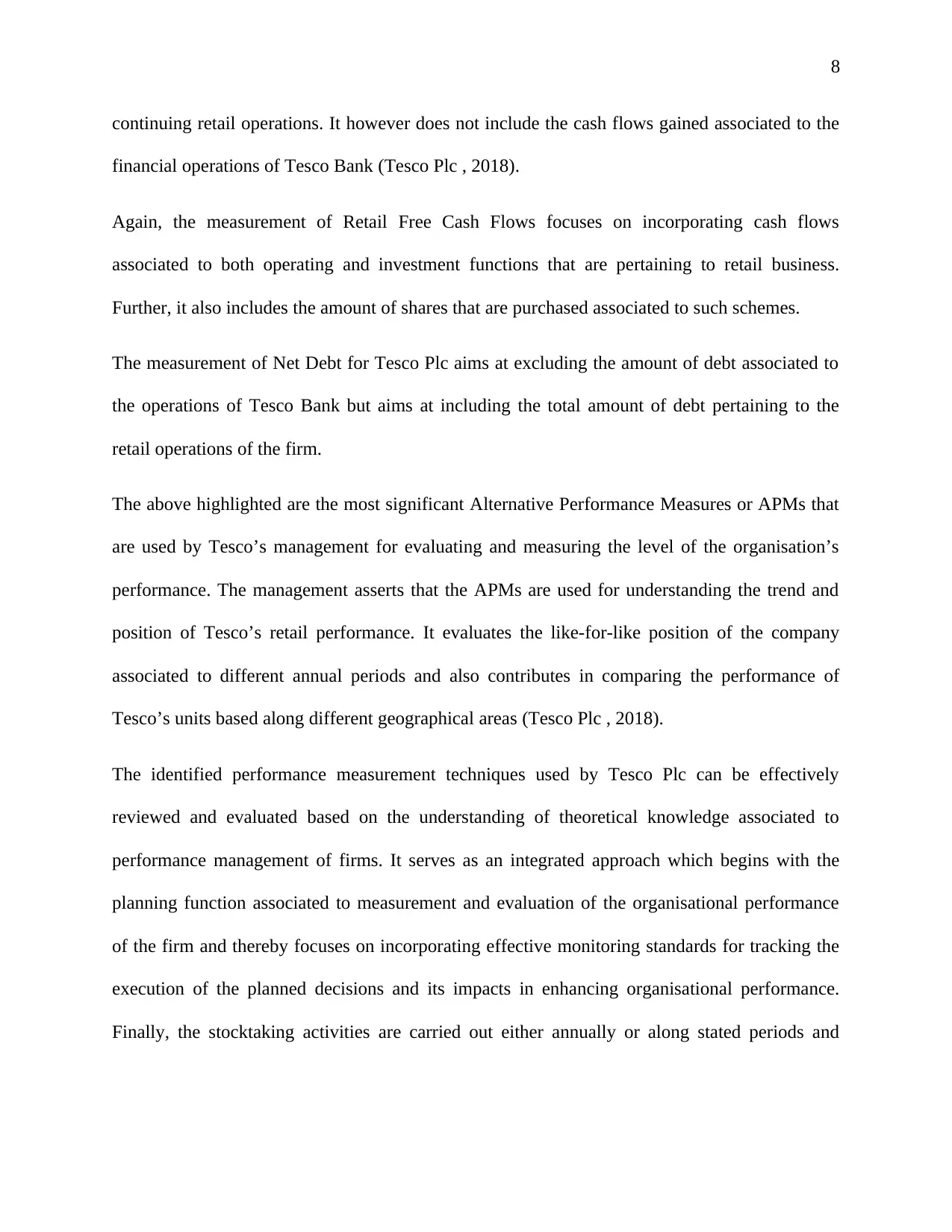
8
continuing retail operations. It however does not include the cash flows gained associated to the
financial operations of Tesco Bank (Tesco Plc , 2018).
Again, the measurement of Retail Free Cash Flows focuses on incorporating cash flows
associated to both operating and investment functions that are pertaining to retail business.
Further, it also includes the amount of shares that are purchased associated to such schemes.
The measurement of Net Debt for Tesco Plc aims at excluding the amount of debt associated to
the operations of Tesco Bank but aims at including the total amount of debt pertaining to the
retail operations of the firm.
The above highlighted are the most significant Alternative Performance Measures or APMs that
are used by Tesco’s management for evaluating and measuring the level of the organisation’s
performance. The management asserts that the APMs are used for understanding the trend and
position of Tesco’s retail performance. It evaluates the like-for-like position of the company
associated to different annual periods and also contributes in comparing the performance of
Tesco’s units based along different geographical areas (Tesco Plc , 2018).
The identified performance measurement techniques used by Tesco Plc can be effectively
reviewed and evaluated based on the understanding of theoretical knowledge associated to
performance management of firms. It serves as an integrated approach which begins with the
planning function associated to measurement and evaluation of the organisational performance
of the firm and thereby focuses on incorporating effective monitoring standards for tracking the
execution of the planned decisions and its impacts in enhancing organisational performance.
Finally, the stocktaking activities are carried out either annually or along stated periods and
continuing retail operations. It however does not include the cash flows gained associated to the
financial operations of Tesco Bank (Tesco Plc , 2018).
Again, the measurement of Retail Free Cash Flows focuses on incorporating cash flows
associated to both operating and investment functions that are pertaining to retail business.
Further, it also includes the amount of shares that are purchased associated to such schemes.
The measurement of Net Debt for Tesco Plc aims at excluding the amount of debt associated to
the operations of Tesco Bank but aims at including the total amount of debt pertaining to the
retail operations of the firm.
The above highlighted are the most significant Alternative Performance Measures or APMs that
are used by Tesco’s management for evaluating and measuring the level of the organisation’s
performance. The management asserts that the APMs are used for understanding the trend and
position of Tesco’s retail performance. It evaluates the like-for-like position of the company
associated to different annual periods and also contributes in comparing the performance of
Tesco’s units based along different geographical areas (Tesco Plc , 2018).
The identified performance measurement techniques used by Tesco Plc can be effectively
reviewed and evaluated based on the understanding of theoretical knowledge associated to
performance management of firms. It serves as an integrated approach which begins with the
planning function associated to measurement and evaluation of the organisational performance
of the firm and thereby focuses on incorporating effective monitoring standards for tracking the
execution of the planned decisions and its impacts in enhancing organisational performance.
Finally, the stocktaking activities are carried out either annually or along stated periods and
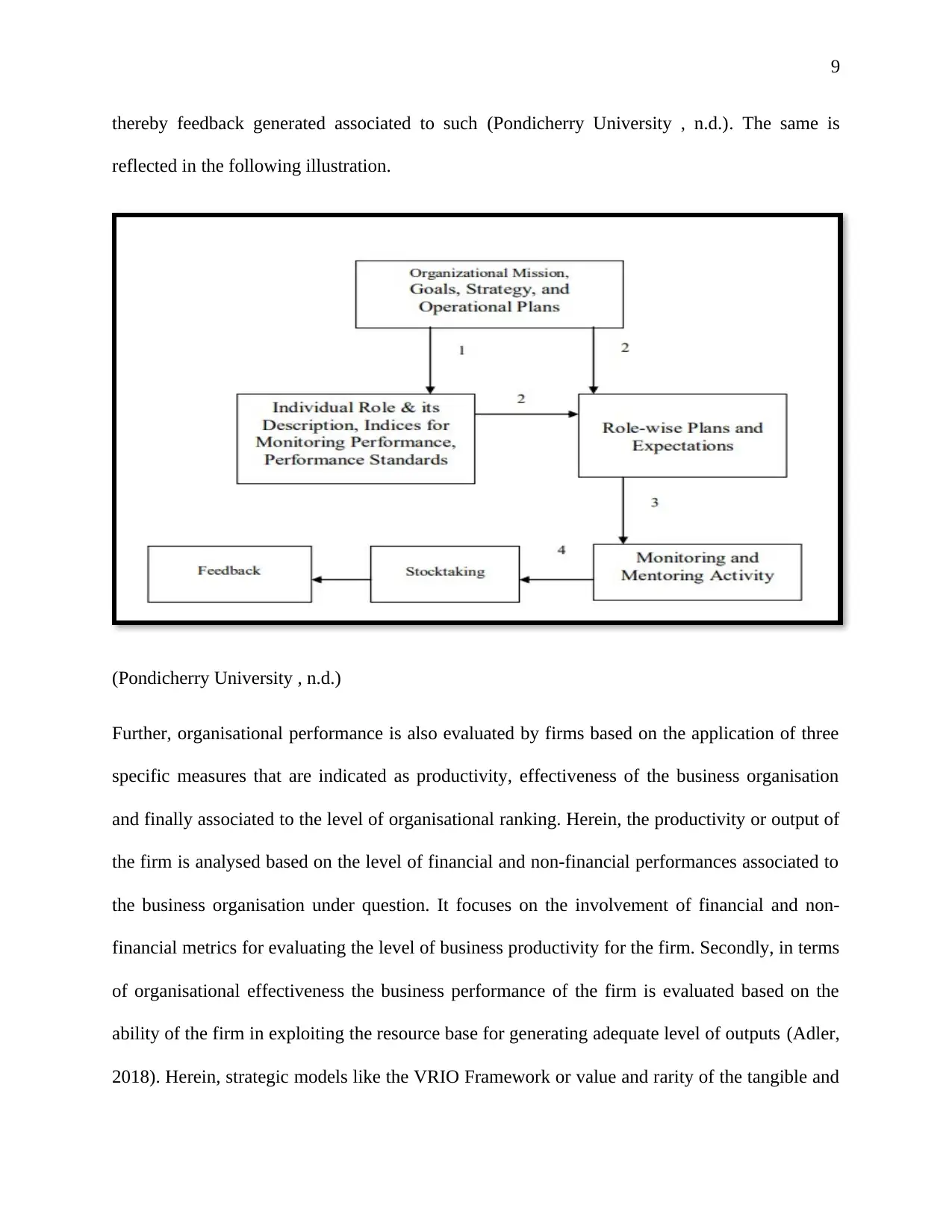
9
thereby feedback generated associated to such (Pondicherry University , n.d.). The same is
reflected in the following illustration.
(Pondicherry University , n.d.)
Further, organisational performance is also evaluated by firms based on the application of three
specific measures that are indicated as productivity, effectiveness of the business organisation
and finally associated to the level of organisational ranking. Herein, the productivity or output of
the firm is analysed based on the level of financial and non-financial performances associated to
the business organisation under question. It focuses on the involvement of financial and non-
financial metrics for evaluating the level of business productivity for the firm. Secondly, in terms
of organisational effectiveness the business performance of the firm is evaluated based on the
ability of the firm in exploiting the resource base for generating adequate level of outputs (Adler,
2018). Herein, strategic models like the VRIO Framework or value and rarity of the tangible and
thereby feedback generated associated to such (Pondicherry University , n.d.). The same is
reflected in the following illustration.
(Pondicherry University , n.d.)
Further, organisational performance is also evaluated by firms based on the application of three
specific measures that are indicated as productivity, effectiveness of the business organisation
and finally associated to the level of organisational ranking. Herein, the productivity or output of
the firm is analysed based on the level of financial and non-financial performances associated to
the business organisation under question. It focuses on the involvement of financial and non-
financial metrics for evaluating the level of business productivity for the firm. Secondly, in terms
of organisational effectiveness the business performance of the firm is evaluated based on the
ability of the firm in exploiting the resource base for generating adequate level of outputs (Adler,
2018). Herein, strategic models like the VRIO Framework or value and rarity of the tangible and
⊘ This is a preview!⊘
Do you want full access?
Subscribe today to unlock all pages.

Trusted by 1+ million students worldwide
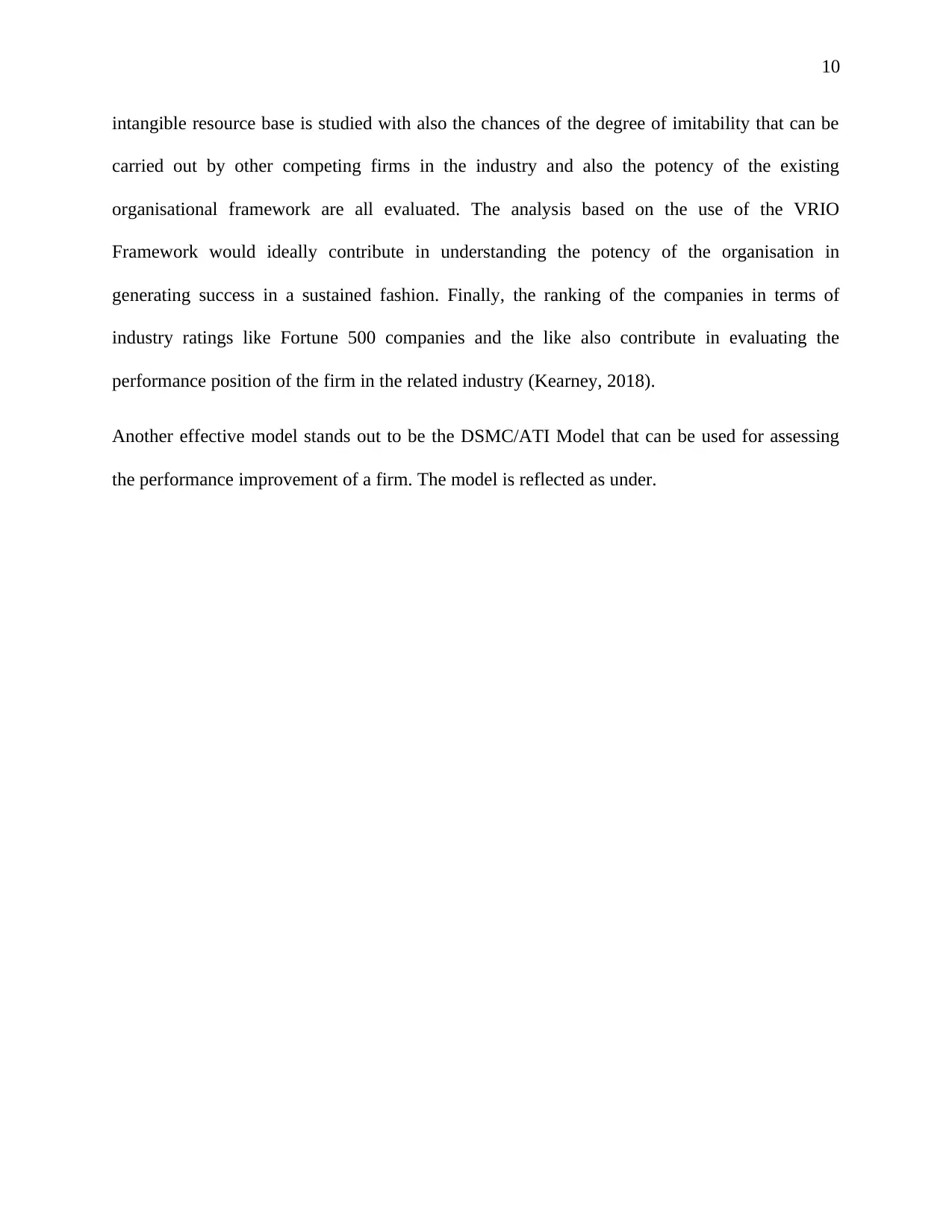
10
intangible resource base is studied with also the chances of the degree of imitability that can be
carried out by other competing firms in the industry and also the potency of the existing
organisational framework are all evaluated. The analysis based on the use of the VRIO
Framework would ideally contribute in understanding the potency of the organisation in
generating success in a sustained fashion. Finally, the ranking of the companies in terms of
industry ratings like Fortune 500 companies and the like also contribute in evaluating the
performance position of the firm in the related industry (Kearney, 2018).
Another effective model stands out to be the DSMC/ATI Model that can be used for assessing
the performance improvement of a firm. The model is reflected as under.
intangible resource base is studied with also the chances of the degree of imitability that can be
carried out by other competing firms in the industry and also the potency of the existing
organisational framework are all evaluated. The analysis based on the use of the VRIO
Framework would ideally contribute in understanding the potency of the organisation in
generating success in a sustained fashion. Finally, the ranking of the companies in terms of
industry ratings like Fortune 500 companies and the like also contribute in evaluating the
performance position of the firm in the related industry (Kearney, 2018).
Another effective model stands out to be the DSMC/ATI Model that can be used for assessing
the performance improvement of a firm. The model is reflected as under.
Paraphrase This Document
Need a fresh take? Get an instant paraphrase of this document with our AI Paraphraser
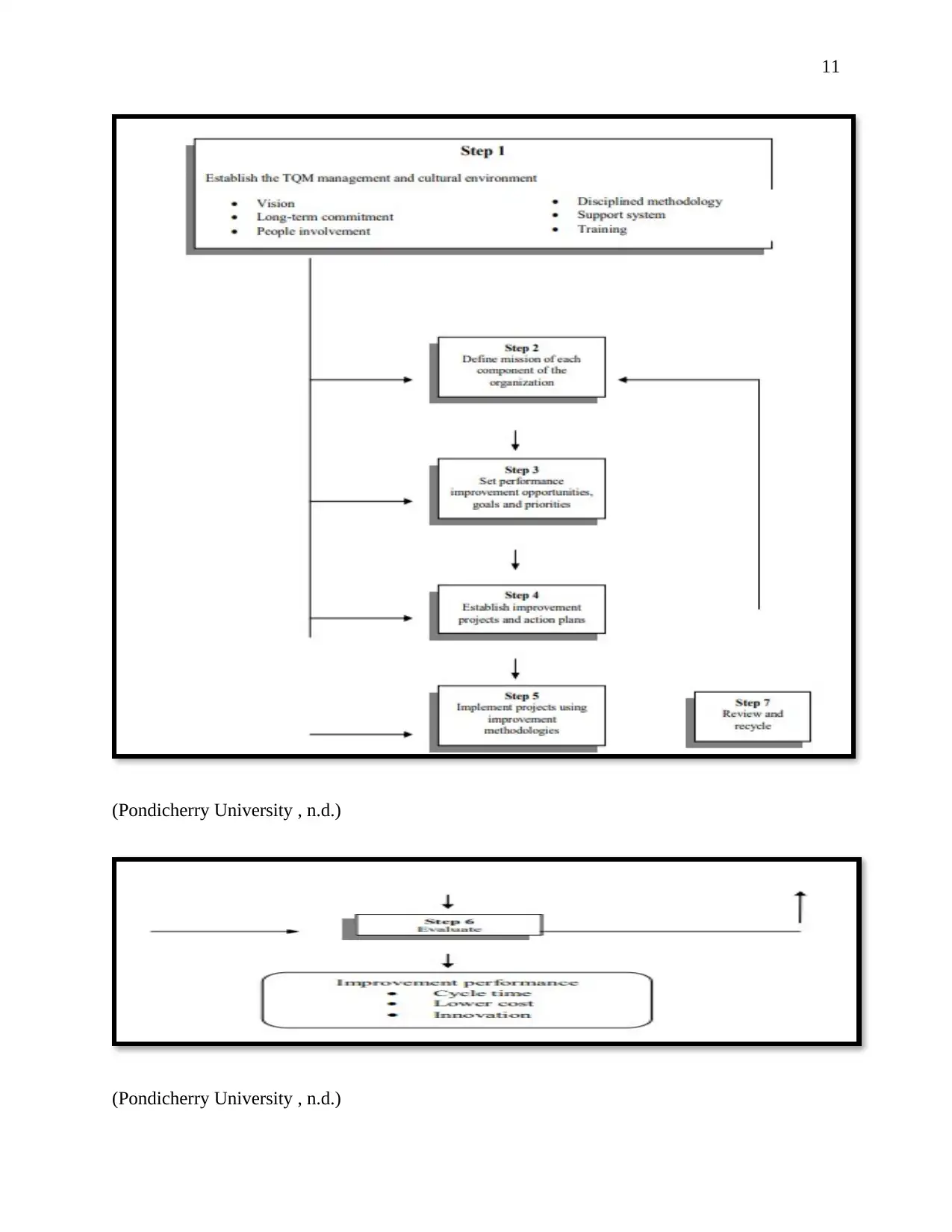
11
(Pondicherry University , n.d.)
(Pondicherry University , n.d.)
(Pondicherry University , n.d.)
(Pondicherry University , n.d.)
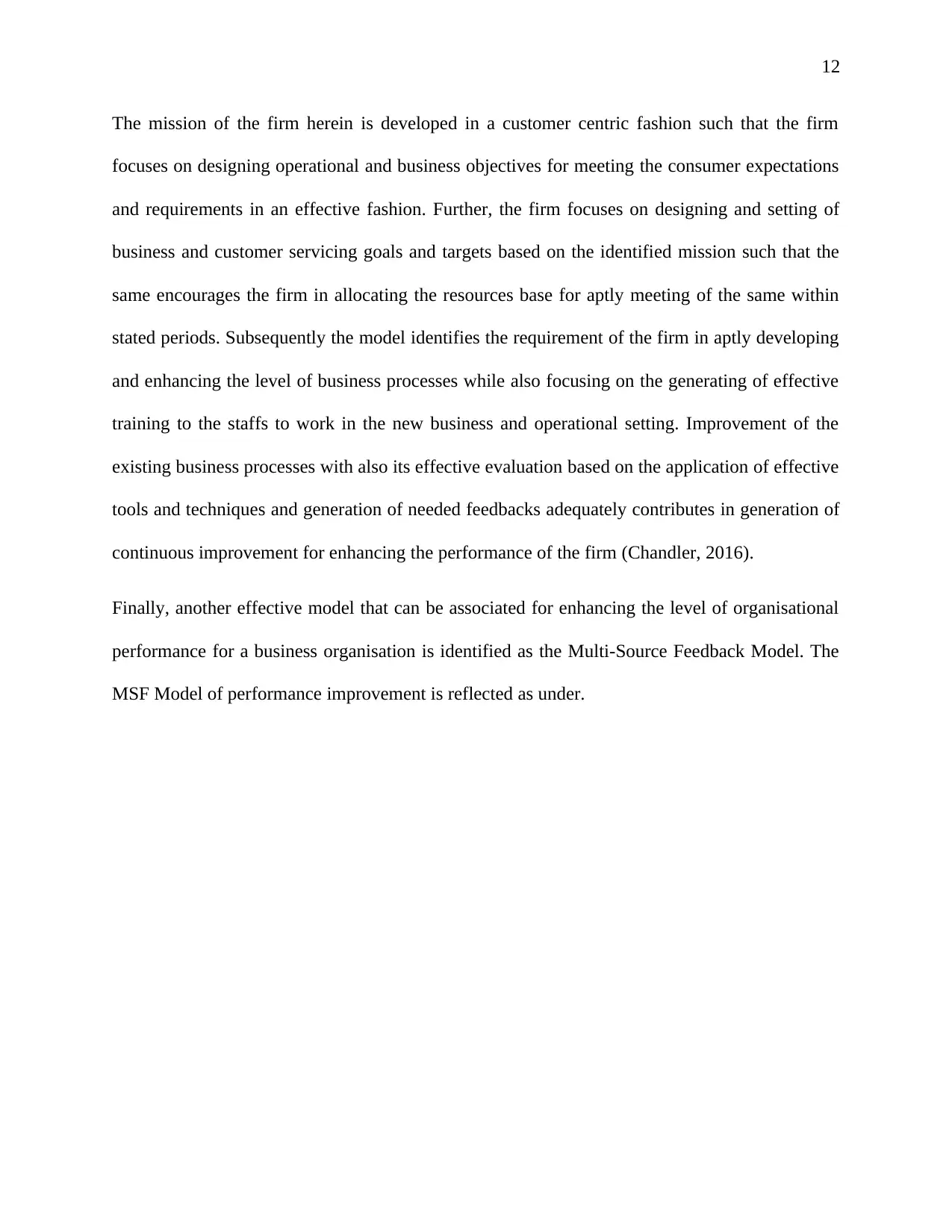
12
The mission of the firm herein is developed in a customer centric fashion such that the firm
focuses on designing operational and business objectives for meeting the consumer expectations
and requirements in an effective fashion. Further, the firm focuses on designing and setting of
business and customer servicing goals and targets based on the identified mission such that the
same encourages the firm in allocating the resources base for aptly meeting of the same within
stated periods. Subsequently the model identifies the requirement of the firm in aptly developing
and enhancing the level of business processes while also focusing on the generating of effective
training to the staffs to work in the new business and operational setting. Improvement of the
existing business processes with also its effective evaluation based on the application of effective
tools and techniques and generation of needed feedbacks adequately contributes in generation of
continuous improvement for enhancing the performance of the firm (Chandler, 2016).
Finally, another effective model that can be associated for enhancing the level of organisational
performance for a business organisation is identified as the Multi-Source Feedback Model. The
MSF Model of performance improvement is reflected as under.
The mission of the firm herein is developed in a customer centric fashion such that the firm
focuses on designing operational and business objectives for meeting the consumer expectations
and requirements in an effective fashion. Further, the firm focuses on designing and setting of
business and customer servicing goals and targets based on the identified mission such that the
same encourages the firm in allocating the resources base for aptly meeting of the same within
stated periods. Subsequently the model identifies the requirement of the firm in aptly developing
and enhancing the level of business processes while also focusing on the generating of effective
training to the staffs to work in the new business and operational setting. Improvement of the
existing business processes with also its effective evaluation based on the application of effective
tools and techniques and generation of needed feedbacks adequately contributes in generation of
continuous improvement for enhancing the performance of the firm (Chandler, 2016).
Finally, another effective model that can be associated for enhancing the level of organisational
performance for a business organisation is identified as the Multi-Source Feedback Model. The
MSF Model of performance improvement is reflected as under.
⊘ This is a preview!⊘
Do you want full access?
Subscribe today to unlock all pages.

Trusted by 1+ million students worldwide
1 out of 19
Related Documents
Your All-in-One AI-Powered Toolkit for Academic Success.
+13062052269
info@desklib.com
Available 24*7 on WhatsApp / Email
![[object Object]](/_next/static/media/star-bottom.7253800d.svg)
Unlock your academic potential
Copyright © 2020–2025 A2Z Services. All Rights Reserved. Developed and managed by ZUCOL.





